
Go World Travel is reader-supported and may earn a commission from purchases made through links in this piece.
As the world opens to travel again, we all look forward to packing our suitcases and taking to the skies in our quest to discover a new locale. At such moments we could avoid high octane destinations and look for places that do not always make it to a tourist’s itinerary.
Getting to Bratislava, Slovakia
Bratislava, Slovakia fits that bill as I discovered during a European trip with my family a couple of years ago. The toned-down city of Bratislava is a 90-minute train ride from Vienna. Day tours with buses are also available.
We took a train from the Wien Hauptbahnhof station in Vienna to embark on a short and picturesque journey to Slovakia.

A Look at Bratislava’s History
Bratislava, the capital of Slovakia, sits along the Danube River with Austria and Hungary on its borders. Slovakia was in the Austro-Hungarian Empire until the end of the First World War and Bratislava was the capital of the Kingdom of Hungary from 16th to 18th century.
The city was included in the newly formed state of Czechoslovakia when it was created in 1919. After its Communist years, Bratislava, earlier known as Pressburg, became the capital of the Slovak Republic (Slovakia).
An inexpensive place to visit compared to the cities of western Europe, Bratislava offers enough attractions and activities for a short visit or a longer jaunt.
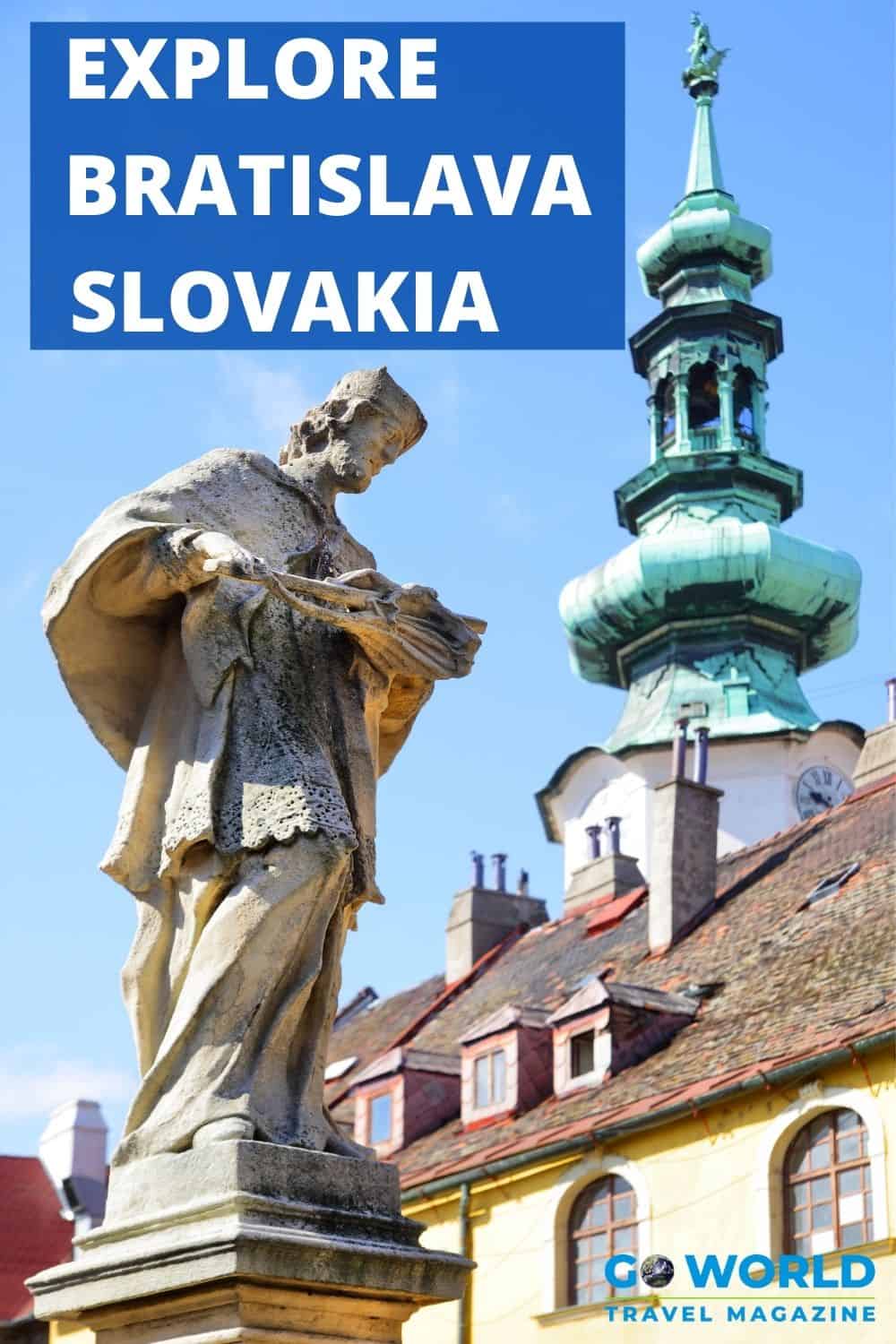
What to do in Bratislava
We departed from our train at the Bratislava Hlavna stanica and I instantly felt the difference. The stark concrete structure of the station was in complete contrast to the sleek Wien Hauptbahnhof. Although the socialist era frescoes in the main hall were impressive.
Following are some of the top sights and things to do in Bratislava even if you only have one day to explore.

Begin at Staré Mesto
Stepping out of the station we were approached by a taxi driver eager to take us to the tourist sites. We started at Hviezdoslavovo námestie (Hviezdoslav Square). This charming plaza is the largest in the historic town. It is shaded with trees and ideal for strolling.
Located in Staré Mesto, the Old Town, the Hviezdoslav square is a pedestrianized zone. It is flanked by historic buildings, expensive hotels, embassies and a variety of restaurants and bars.
On one side of the square is Bratislava’s Opera House. A magnificent Neo-Renaissance edifice built in 1886. The structure is known as the historical building of the Slovak National Theatre.
It was designed by the Vienna-based architect duo Ferdinand Fellner and Hermann Helmer. A duo known for their designs of eclectic opera houses and theater buildings in several European cities.
Facing the theater is Ganymede’s Fountain in Neo-Baroque style. The fountain depicts ancient Greek mythological figures. It is from 1886 and was designed by V. Tilgner who also created some of the sculptures that adorn the theater building.
Enjoy this Bratislava Riverside Castle Tour.
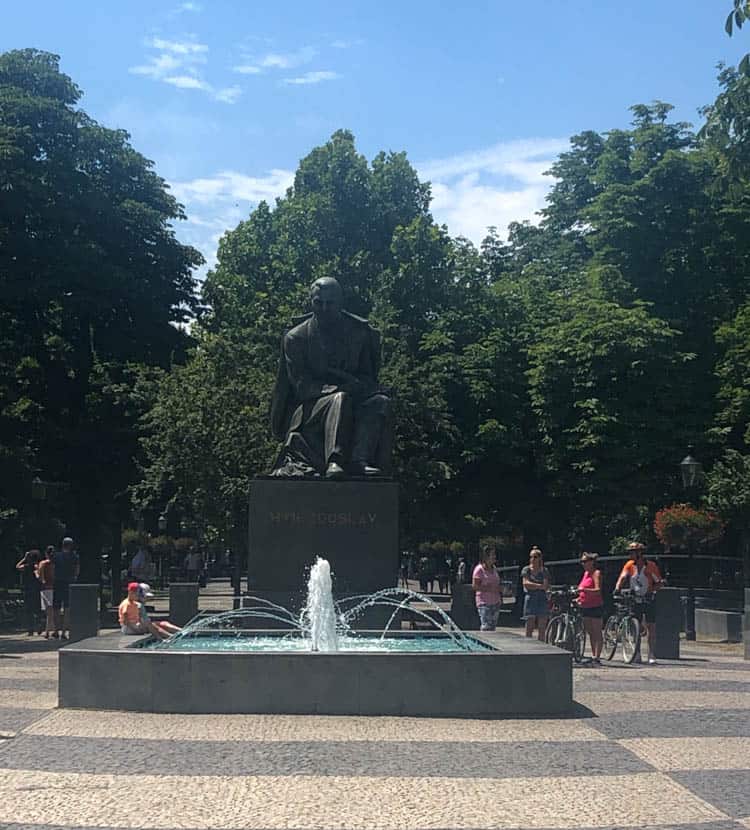
An Imposing Statue
On the other end of the square, I noticed an imposing statue. It occupies a prominent place, overlooking a rectangular fountain. The larger-than-life seated bronze figure is of Pavol Országh Hviezdoslav, after whom the square is named.
Hviezdoslav was a renowned early 20th century Slovak poet, playwright, translator and dramatist. If you walk a few steps behind him, you will also see a beautiful statue of Hans Christian Andersen surrounded by a few of his created characters.
Take this Bratislava 10-City Highlight Phone Guided Tour.
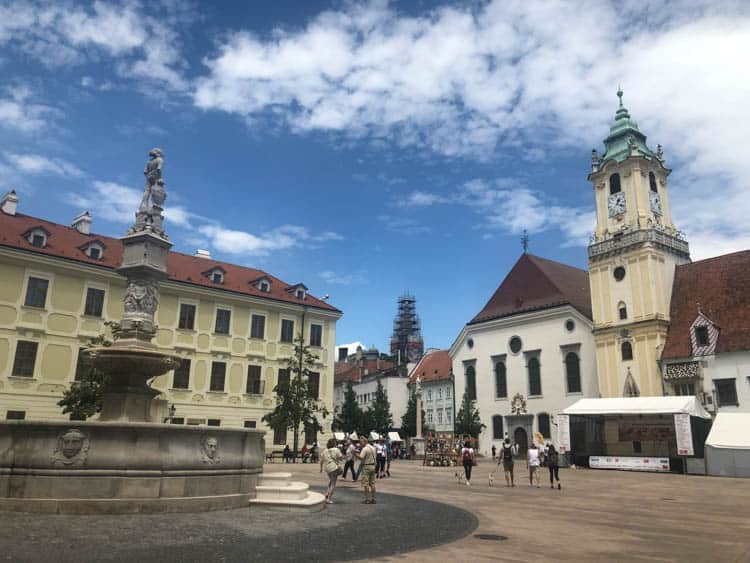
The Architectural Beauty of the Historic Center
Continuing our walk on lovely, cobblestone streets, we reached the Main Square of Hlavné námestie. This spot is often considered to be the city center and has existed for centuries.
This historic hub of Bratislava has paid witness to festivals, coronations and even public executions. All around us was architectural splendor restored to their former glory. Painted in white, pastel blues, yellows, greens and pinks. Buildings of note surround the square.
The Stará Radnica (Old Town Hall) with a beautiful clock tower is a masterpiece complex of 14th and 15th-century buildings. They display a variety of styles dating back to the Gothic period. The oldest structure is the tower which was constructed in 1370. The buildings are the oldest standing stone structures in Bratislava.
The buildings functioned as the city town hall for over 400 years and today house the Bratislava City History Museum. The museum documents the history and culture of the city from the Medieval ages to the present day.
The Roland Fountain, sometimes called the Maximilian Fountain, located in front of the Old Town Hall will catch your eye. The Renaissance-style fountain was built in 1572. It has a central column with a statue of knight Roland on top.
Roland is the legendary protector of the city. Although rumors abound that the statue is of King Maximilian II of Hungary, the first monarch to be coronated in Bratislava in 1563.
Enjoy this Bratislava City Highlights Running Tour.

Palaces in the Square
About a five-minute walk away from Roland Fountain is another spectacular Baroque building, the Reduta Palace. The palace is the venue for inauguration ceremonies for newly elected presidents.
Starting out as a granary in 1773, the building went through various iterations with elements added in Rococo and Art Nouveau styles. With a 700-seat facility, the Reduta is now the home of the Slovak Philharmonic.
Where the Main Square meets the Primate’s Square, we came upon another fantastic building, resplendent in its pink and gold facade. This was the Primate’s Palace, Neoclassical in style and built in the 18th century for the head of the Catholic Church in Hungary (The Primate).
Now it is the seat of the Mayor of Bratislava. Go see the Hall of Mirrors, the only place that allows photography. The beautiful English tapestries, the picture gallery and salons and the Chapel of St. Ladislaus are also worth stopping by if you decide to tour the interior.
We walked into the inner courtyard, passing through a pillared hallway, and noticed a splendid statue and fountain. The sculpture of St. George depicts the legendary knight astride his horse defeating a three-headed dragon.
For information on concerts at Reduta: http://www.filharmonia.sk/en

More Superlative Palaces and Sculptures
The Old Town and the Main Square are like a jewel box of exquisite buildings. I learned they were all palaces from the 16th-19th centuries.
The Palugyay Palace, an ornate Neo renaissance building from the late 19th century, underwent major renovations and now hosts the Slovak foreign ministry. Jeszenák’s Palace, a white Baroque building from the 18th century, is now the Greek Embassy.
On the ground level of the embassy building, Kaffee Mayer, a Viennese-style café, has been holding forth since 1873. We absolutely had to admire the sculpture, Schöner Nàci, situated near the entrance.
Náci is a fine life-size statue of Ignác Lamár. Lamár is renowned locally as a person who, although being poor, dressed in classy clothes and tried to bring happiness by singing songs and greeting people walking the streets of the Old Town. It is said he took inspiration from his grandfather who was a clown.
A bright yellow Rococo-style building from the mid-18th century was the Palace of Leopold von Kutscherfeld, today the dwelling of the French Embassy. Outside is another unconventional bronze statue of a Napoleonic soldier leaning against a bench. It is a symbol of the Napoleonic attacks on the city in 1809.
Next to the Embassy building is the Viceroy’s Palace which served as the seat of Viceroys of the Habsburg dynasty who ruled their kingdom from Vienna. The building of the Hungarian Exchange Bank, an Art Nouveau structure from the early 20th century, will also attract your attention.

Strolling Around Main Square
The many bumpy stone streets that fan around Main Square are dotted with erstwhile palaces and burgher houses. Glimpsing their lovely exteriors made our walk delightful.
Some of the streets were quiet. Others were crowded with tourists enjoying their time at the abundant cafes and restaurants occupying the street levels of the palace buildings.
We walked by boutiques and souvenir stores geared towards tourists but interesting, nonetheless. We spent a few minutes looking at local handicrafts and knick-knacks. The summer months see the square bustling with local crafts markets while in the winter Christmas markets light up the area.
Noticing a mini crowd pointing their camera phones to the ground to click pictures, we walked up to discover another statue. Rubberneck Čumil, “the man at work” or “the sewer worker” or “the voyeur” is a sculpture of a man peeking out from a manhole that has become an institution.
Sculpted in bronze by Viktor Hulík in 1997, this quirky statue was installed as part of efforts to spruce up the area after the end of the Communist years.
Enjoy this Christmas Market Tour.

In The Footsteps of Royalty
For our next sightseeing stop, we headed towards the distinctive Michael’s Gate (Michalská brána) with its green copper roof. It is the only preserved landmark from the medieval era fortifications that surrounded the Slovak capital.
Dating from around 1300, it’s one of four gates into the city. The gate was reconstructed in the Baroque style in 1758 when the statue of St. Michael slaying the dragon was added on top of its tower.
At the exit (or entrance) to the gate, you will notice a golden compass embedded in the ground showing distances to 29 cities of the world. If you have time, climb to the top of the gate to get wonderful views of the city. There is also a small museum displaying weapons.
Take a peek at the medieval Baštová Street near the gate, considered to be the thinnest street in Bratislava. Though home to the city hangman for many years, it’s now full of bars and restaurants.
Follow the crowns on the cobbled street to walk in the footsteps of monarchs to the 13th century St. Martin’s Cathedral. This was the coronation venue of kings and most notably of Queen Maria Theresa, the only female ruler from the House of Habsburg. Its stunning, gilded spire dominates the skyline of the Old Town.
Enjoy this Afternoon Sightseeing Walking Tour.

Bratislava Castle
If you have more than a day at hand, a visit to Bratislava Castle is a must. We got a glimpse from our taxi and a glance from the Old Town. I wished for time to stand still so we could pay a visit.
A castle on a hill overlooking the River Danube, its ramparts are visible from all directions and make for an impressive sight with its four red turret towers. Home to the Crown Jewels of Hungary for over 200 years, the castle has a storied history with its site showing archeological remnants from the Iron Age.
The construction of the present castle began in the 10th century. Within a few hundred years, Pressburg Castle, as it was earlier known, became one of the most important royal castles in Europe.
Today, you can tour the castle and its verdant gardens, visit the Slovak National Museum and the Treasury and climb the Crown Tower for exquisite views. Additionally, you can dine at the fine restaurant, Modrá Hviezda, located near the castle.
Enjoy this 2-hour City Walking Tour with Castle Ticket.
Find information here: https://www.snm.sk/?visiting-3

The Presidential Palace
As we returned to the train station we decided to take a 20-minute stroll to Hlavna stanica. Heading out of Michael’s Gate, we walked on a lovely wrought iron pedestrian bridge over the moat.
I noticed a corner of the bridge with multiple locks tied around the railings and the intricately carved lamp post. Curiosity made me take a picture.
A quick search on the internet revealed them to be love locks. Couples use the locks to symbolize their love and the key is thrown away to herald their love to be everlasting.
We turned around to get one last look at the towering Michael’s Gate and the eye-catching views of the Old Town before making our way down to the street level. A few minutes walk and there we were in front of arguably the most famous palace in Bratislava.
Grassalkovich Palace (the Presidential Palace) was built in 1760 and is the seat of the Slovak president, though he does not reside there. It was used for events and parties by the Habsburg royalty.
The palace is open to tourists only one day a year. However, the park, originally a French formal garden, is accessible and you must visit if you have the time. We however were not so lucky, it was past 7 pm and the park had closed for the day.
Enjoy these Bratislava Riverside Castle or Complete City Segway Tours.
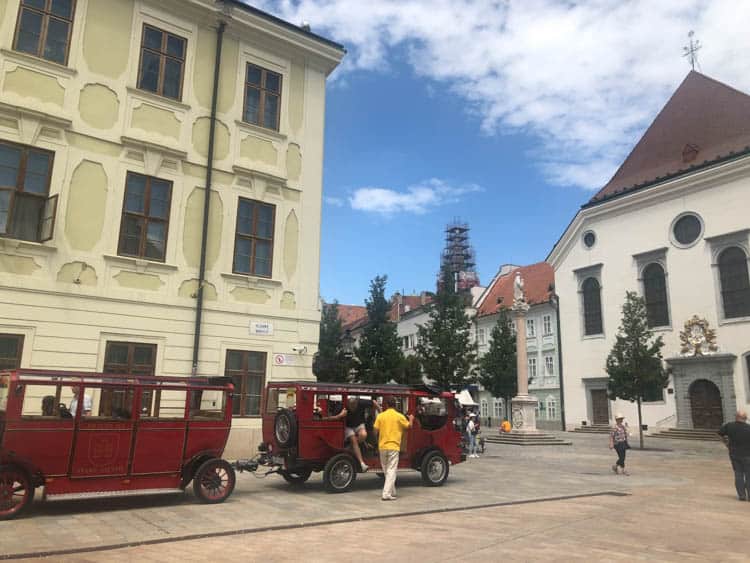
The Presporacik Oldtimer
To try and fit in as many attractions as possible in a day your best bet would be to ride the Presporacik Oldtimer. We noticed the bright red two-car train at Hlavné námestie. Book your seats prior to your trip or you may have to go without as each train has only 30 seats and they sell out fast.
Information is here: https://presporacik.sk/en/
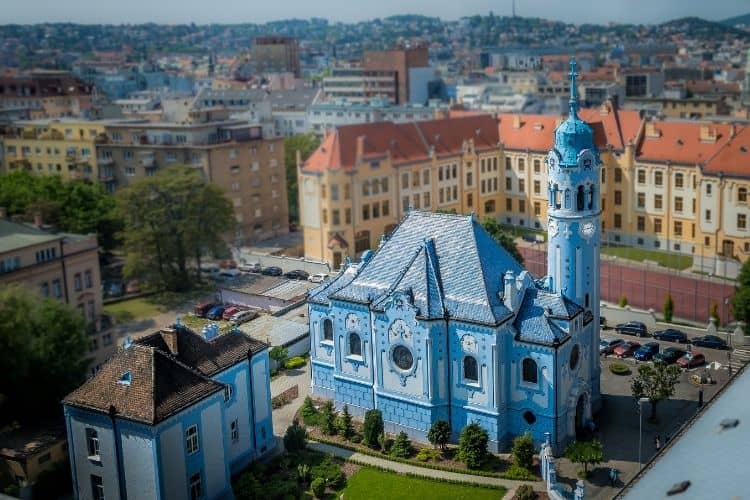
More Attractions in Bratislava
Because of our short day trip, we missed out on a few unbeatable attractions. But with some prior planning, you will not have to do so.
There are many churches in Bratislava and most of them look like they sprung out of fairy tales. I was glad to have looked at St. Martin’s Cathedral with its stately tower. Also, I enjoyed walking by the Jesuit Church from the 17th century with its embossed coat of arms in the Old Town.
It would have been a full circle if we could have seen the Blue Church, located in a far corner of the Old Town. It was built in the early 20th century by a Hungarian architect. As the name suggests, the church is entirely blue.
The Communist era also left its mark on the city. Start with the Most SNP Bridge, built 1967 – 1972, and known as the Bridge of the Slovak National Uprising.
It is also known as the UFO Bridge due to the look of the towering observation deck. From here you will get spectacular views over the Danube and into Austria. You might even want to round out the trip with dinner at the attached restaurant.
Finally, Devin Castle (Hrad Devin), dating from the 10th century is a 20-minute drive from the Old Town.
Book This Trip
Ready to explore the beauty of Bratislava? Get prepared with local restaurant reviews, hotel or VRBO recommendations, insider tips on how to get around and more through Travelocity and TripAdvisor. When you are ready to book, check out Omio Travel Partner for plane, train and auto reservations.
Dining options: The Old Town and the surrounding areas have restaurants, cafes and bars aplenty serving cuisines from around the world. But you must try some Slovak specialties such as bryndzové halušky (sheep’s cheese dumplings), zemiakové placky (potato pancakes), vyprážany rezeń (fried schnitzel) or parená knedła (steamed bread dumplings). Our restaurant had a display board with photos of traditional food, making it easy for us to choose.
Visit Bratislava: www.visitbratislava.com/
For train schedules and tickets: Rail Europe or The Trainline
Author Bio: Susmita Sengupta, an architect by background from New York City, loves to travel with her family. Her articles are published in many online travel magazines including Go World Travel.
- Palawan Perfection: Exploring the Philippines’ Last Ecological Frontier - July 13, 2025
- A Journey to Ashland, Oregon’s Shakespeare Festival - July 13, 2025
- The Ultimate Guide to Cairo’s Top Three Museums: Which Should You Visit? - July 12, 2025
